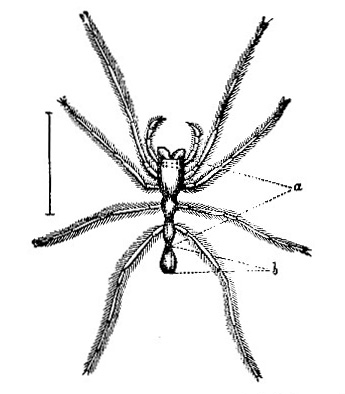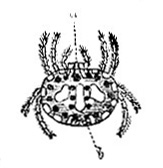(30) ARACHNIDA - ORDER VII: ARANEIDEA - ENEMIES OF SPIDERS
Preying upon all the insect tribes, and occasionally upon lizards (F. Pollock, Ann. N.H. October 1872) and earth-worms (E. Simon in Ann. Soc. Ent. France, 1873, 5 ser. Tom. iii. p. 114- and Zoologist, 1856, p. 5021), spiders are also themselves preyed upon by both lizards and insects. More than one species of parasitic hymenoptera tend to keep spiders within due bounds; but little has yet been done towards working out these parasites. Three species are figured in Blackwall's Spid. Great Britain and Ireland, pl. xii.; two of them prey upon Agroeca brunnea (Bl.); while the third, Pompilus sepicola (F. smith), pierces large spiders, paralyzing, but not killing them; they are then dragged to its nest, in a hole in the earth; eggs are laid in the spider, which retains sufficient vitality to furnish fresh food to the parasitic larvae until the time for their change to the pupa state arrives. Full-grown females of Lycosa campestris (Bl.) have been found by the writer in the grasp of this powerful ichneumon. From the outskirts of a single web of Epeira opuntioe (Duf.), on the shores of the Sea of Galilee, the writer collected, in April 1865, many truncated pear-shaped egg cocoons belonging to the beautiful little Argyrodes epeiroe (Sim.); and from each of these cocoons a single hymenopterous parasite shortly issued. The egg cocoons of various epeirids in England are likewise often preyed upon by numerous minute parasites of the same order. Several species of Theridion.T. simile (Koch) especially-are subject to a larval parasite, often as large as the spider itself, adhering to the outside of the abdomen. Various attempts to rear the perfect insect from this parasite have hitherto failed. A wide field of great interest is open to any one who should take up the investigation of the various insect parasites of spiders, with their mode of attack and subsequent victory.

Fig. 31 -- Ant-spider (Myrmecia fulva, Latreille). a, cephalo-thorax; b, abdomen.

Fig. 32 -- Crab-spider (Eurysoma cabindae, Capello). a, cephalo-thorax; b, abdomen.
Other foes, common to all the Articulata, spiders also have in abundance-birds, small mammals, and reptiles. Doubles we are indebted to such enemies for the development, through natural selection, of many spiders protected by horny integuments, and often armed with spines to an extent that would make them a painful meal to any bird or other creature that should set itself to dine upon them. Phoroncidia Thwaitesii (Cambr.), found in Ceylon, and Pycanantha Meadii (Bl.), found in Africa, and indeed all the Gasteracnthides, are notable examples of this protective armature. Protective "mimicry" is also seen in spidres, some so exactly resembling ants, that placed side by with species of ants found in the same localities, even a practiced eye would not detect the spider at first sight. Of this nature are the Myrmecides (fig. 31) and some of the Saltici, and notably, Aphantochilus Rogersii (Cambr.), found in Brazil. Other spiders, again (Genus Eurysoma, ) Koch, and Cyrtarachne, Thor.), closely resemble some species of ohytophagous coleoptera; one of the latter genus found in Ceylon, but yet undescribed, resembles, a small mollusk. Of the former some are very like a minute crab (fig. 32). And lastly, to sum up the enemies of spiders, they prey on each other, and are preyed upon also by other Arachnids; but on the whole they have, as by their office they should have the best of it , for they are against all the Articulata, but only comparatively a few of the Articulata are against them.
Spiders are not creatures which belong solely to the present geologic era of the earth, for fossil spiders, with other Arachnids, as well as spiders in amber, have been found; the oldest in the coal formation. See on this subject a late resume by Dr. T. Thorell, On European Spiders, pp. 220-233, with other works there quoted.
Read the rest of this article:
Arachnida - Table of Contents
|

